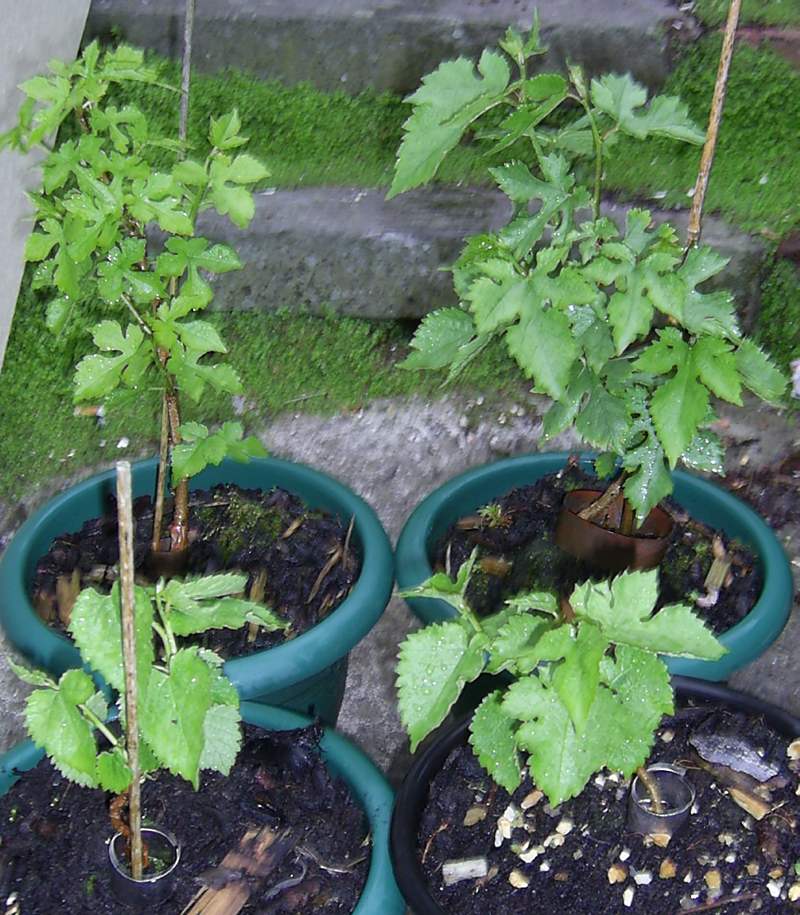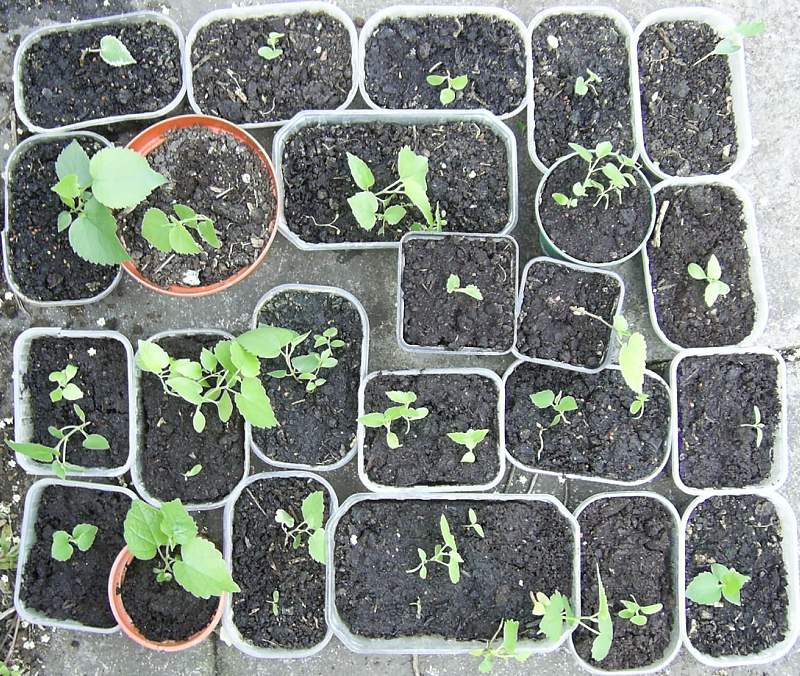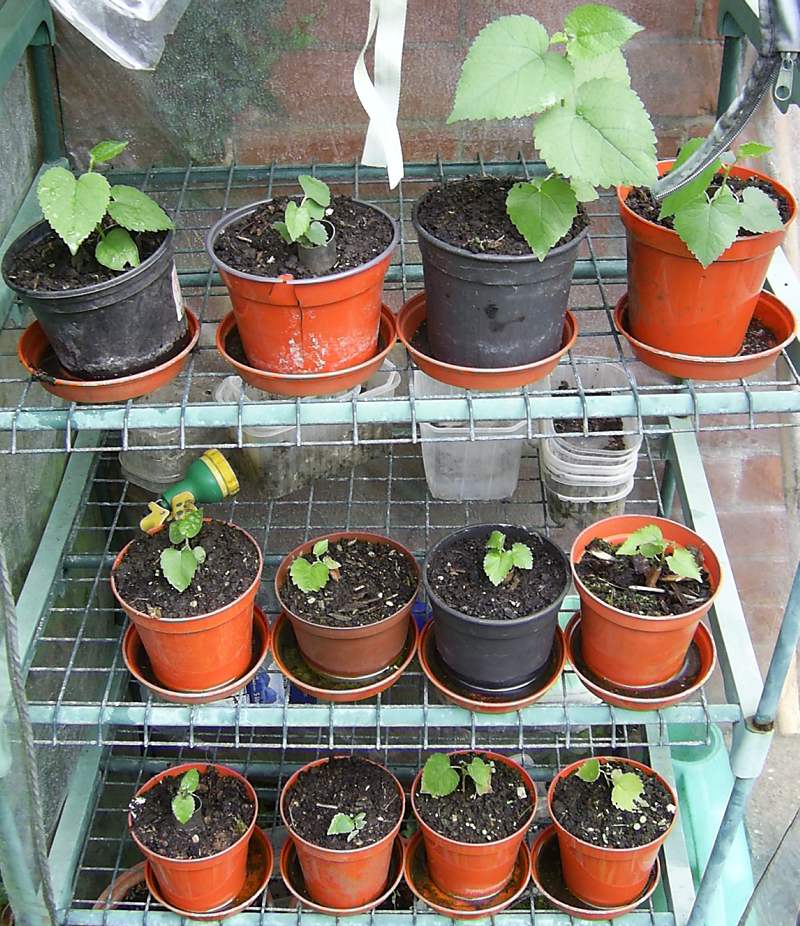Mulberry Tree - Propagation
Mulberry trees are not terribly dificult to
propagate.
However black mulberries appear to be domesticated -
and probably only reproduce in England with human
assistance. I have yet to witness a black mulberry
sapling growing naturally anywhere near the base of
its parent.
Mulberry trees are slow-growing - which means
that propagation efforts will typically not bear fruit
for many years.

Plants 2-3 years old
Propagation can be done via seeds or cuttings.
Seeds have the advantage of ensuring the young plant
has few pathogens.
However, cuttings allow a tried-and-tested genotype to
be used.

Young seedlings
Seeds can be obtained for common mulberry varieties
directly from fruit - or from the internet.
If fresh fruit is the source, cleaning the flesh from
seeds is tedious - but needs to be done to prevent
moulds forming.
Seeds are supposed to benefit from cold stratification
- however they germinate pretty well without it, at
any time of the year - if provided with suitable
conditions.
I clean the seeds, bury them seeds under about 1mm of
purchased compost in the illustrated containers,
put them in a heated incubator and keep them moist.
Some seeds germinate later indoors without heat - if
left long enough.
The germination rate is reasonable, and the infant
mortality rate is fairly modest.
It has been suggested - in a paper entitled
"Does Ingestion by Birds Affect Seed Germination?" -
that Morus Nigra seeds germinate better after passage
through a bird's gut. However, they seem to germinate
reasonably well without this treatment.
Mulberry seedlings have relatively fragile roots, and
these are easily damaged while pricking the seedlings
out. It seems best to prick them out as soon as the first
signs of germination appear - if space permits.

Plants outside in pots
In England, the next problem is the first winter.
Established specimins can be put outside to winter -
however more recent seedlings that have not yet
developed a woody stem may need to be kept under
glass. If they do not actually freeze, mulberry
seedlings become dormant in the winter - but do not
lose their leaves.
 If they survive the winter, another common problem is
extended dormancy. Mulberries put their tasty leaves
out tentatively, and drop them at the first sign of
frost. They spend much of their time in a dormant
state - and sometimes they do not wake up.
This is a fairly common problem - affecting perhaps
20% of seedlings. I lost my very first mulberry
seeding after two and a half years due to this
problem.
If they survive the winter, another common problem is
extended dormancy. Mulberries put their tasty leaves
out tentatively, and drop them at the first sign of
frost. They spend much of their time in a dormant
state - and sometimes they do not wake up.
This is a fairly common problem - affecting perhaps
20% of seedlings. I lost my very first mulberry
seeding after two and a half years due to this
problem.
There is often a solution: brutal surgery. If a
mulberry is still dormant by the start of summer it
will probably stay that way permanently - if
left to its own devices. Fortunately, dormant mulberry
seedlings can often it can be brought back to life -
by chopping off their top along with any existing
leaves. The cut should be made above the most
promising-looking bud. Cutting close to the ground is
OK.
Such surgery apparently sends the plant into an
emergency state - where it heavily prioritises putting
out new foliage. It often seems to be enough
of a shock to wake up a dormant plant.
After six months or so, plants should be placed in
pots outside. After a year or two, they may be
transplanted to their proposed location -
unless this is frequented by deer, or other large
herbivores.
Various ants may attack and destroy mulberry
seedlings. In particular, the yellow meadow ant -
Lasius flavus - will happily move into the moist
basement of a mulberry seedling, plant its
sap-sucking aphids on the roots, and suck the plant
dry until it is dead. This is a relatively common
fate of mulberry seedlings, in some areas. I
recommend the use of ant powder. Also - if possible -
avoid planting out near existing Lasius
flavus nests.
Note that some young mulberry plants exhibit an
unusual lobed leaf shape. This is perfectly normal -
and does not indicate any genetic abnormality.
Because mulberry trees are so slow to grow,
they may need their light defending against
faster-growing neighbours for many years -
if they are to survive and thrive.
Mulberry trees may also be propagated vegetatively.
There is a separate page about that here.
|